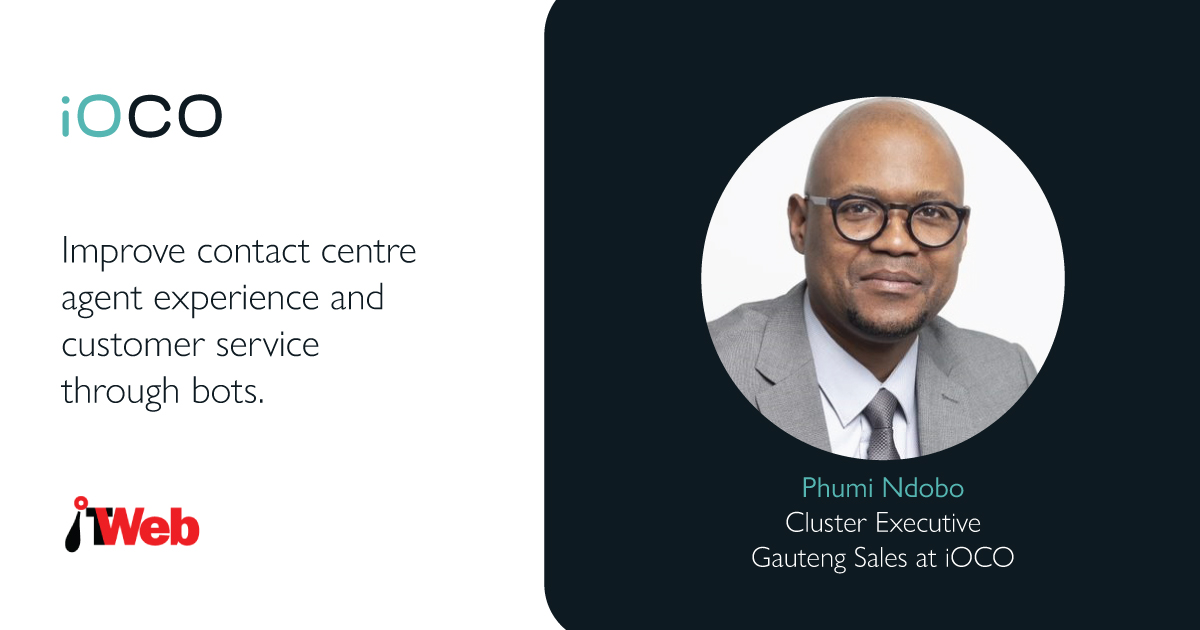Intelligent bots are helping improve customer service and contact centre agent experience, and will play an important role in the contact centres of the future.
This is according to Johan du Preez, Business Development, Automation at iOCO and Phumi Ndobo, Cluster Exec, Gauteng Sales at iOCO, who were speaking during an iOCO webinar on the impact of bots on customer experience.
Du Preez and Ndobo said bots were among the digital technologies transforming contact centres and helping reduce call handling times, cut costs and improve customer experience.
Du Preez noted that bots, digital agents and intelligent assistants, along with integrated systems, and more effective use of data using analytics and intelligence, could significantly improve contact centre processes and experience.
“Common challenges we find in contact centres in SA today are limitations in self service, limited 24/7 availability, long waiting times due to a lack of agent resources, call dropping and call bouncing, and inconsistency across channels. In the operational sphere, challenges include complex and siloed technology landscapes, high costs including staff and per seat licensing of telephony platforms, slow service, always being reactive, and poor use of analytics despite having a great deal of data,” he said.
“What can be changed? Bots can be harnessed to help drive down call volumes and assist customers, and digital workers can help agents to be more efficient and effective. Organisations also need to build out rich digital channels where customers can serve themselves, and provide a single integrated portal so agents know exactly what customer needs, what they have done and products they have, at a glance,” he said.
“From an operational point of view, companies need integration through portal and backend systems, workflow and task automation to be used more effectively, and to use their data for trend analytics and issue identification. Contact centres need to expand and extend customer self-service capabilities to allow 24/7 support, rapid call resolution, reduced or eliminated call bouncing, and proactive communications of issues.”
Ndobo highlighted a case study in which a local telco achieved significant savings and slashed call handling times by deploying intelligent bots, integrating disparate systems and equipping agents with consolidated single pane of glass front ends.
“Today, you have to move fast and show value quickly. In this case, the customer had faced the challenges of high costs per contact, slow handling times, multiple backend systems with many interfaces for agents to navigate, a need for multiple contacts instead of first call resolution, sub-optimal leveraging of the data, frustrated customers and frustrated agents. 23% of the call volumes related to the RPA use case, so this was a candidate for RPA. The solution was a consolidated front end with a single pane of glass for agents, and various automation approaches. These included digitising and automating processes through workflow/BPM, integration where possible and feasible, unattended bots where full automation is possible but integration is not feasible, and attended automation where human interaction is still required.”
“This reduced call handling time from 8 minutes to under 2 minutes in the highest volume call category, optimised cost per contact, reduced need for call bouncing, and improved first call resolution, which results in a significant improvement in employee experience,” he said.
“The technology outcomes included a removed need for an expensive platform replacement, a low level of intrusion on existing systems which allowed back office staff to keep working without process interruptions, and a more modern architecture and leveraging of existing licensing requirements. Crucially, these solutions reduced the costs of handling this category of calls from over R20 million a year to around R2.2 million a year, and made agents four times more effective by slashing call handling times.”
Du Preez said that in order to transform, contact centres should make quick, incremental moves: “Go back to basics: solve the right way. Start with core drivers and business imperatives. Whether this is cost saving, customer service or revenue generation, it is important to understand the organisation’s core drivers upfront. Based on these, the organisation must identify candidate scenarios and analyse the available data to determine which would best meet the mandate; they should then define, design, integrate and develop solutions; and finally evaluate and measure the real impact of implementations by reviewing metrics such as call volume reduction, cost reduction or sales metrics. Go for rapid value deployments with quick minimum viable products to see constant value in the business.”



